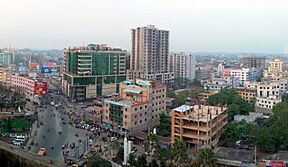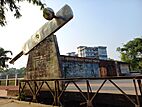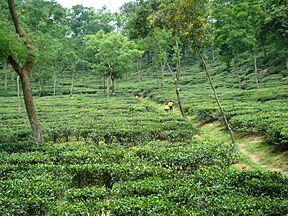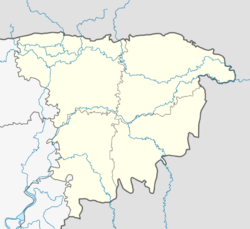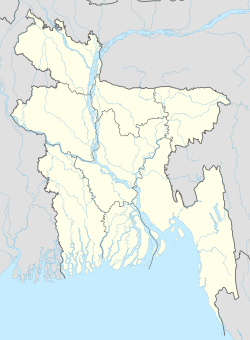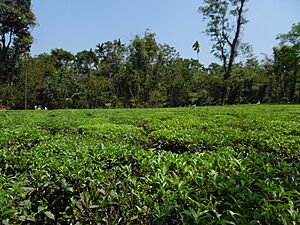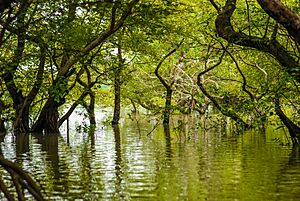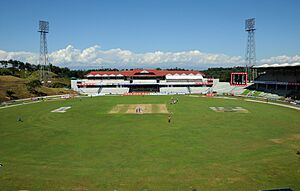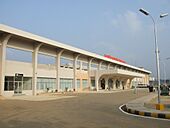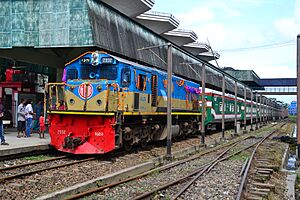Sylhet facts for kids
Quick facts for kids
Sylhet
সিলেট
ꠍꠤꠟꠐ Srihatta, Jalalabad
|
|
|---|---|
|
Downtown Sylhet
Ali Amjad's Clock
Sylhet Railway Station
Shah Jalal Dargah
Sylhet International Cricket Stadium
Malnicherra Tea Estate
|
|
| Country | |
| Division | Sylhet Division |
| District | Sylhet |
| Municipal Board | 1867 |
| Sylhet City Corporation | 9 April 2001 |
| Metropolitan city | 31 March 2009 |
| Government | |
| • Type | Mayor–Council |
| • Body | Sylhet City Corporation |
| Area | |
| • Urban | 58 km2 (22 sq mi) |
| • Metro | 518.43 km2 (200.17 sq mi) |
| Elevation | 35 m (115 ft) |
| Population
(2011)
|
|
| • Metropolis | 1,316,467 |
| • Density | 19,865/km2 (51,450/sq mi) |
| Demonym(s) | Sylheti |
| Time zone | UTC+6 (BST) |
| Postal code |
3100
|
| HDI (2019) | 0.631 medium |
| International airport | Osmani International Airport |
| Regional Calling code | +880821 |
| Police | Sylhet Metropolitan Police |
Sylhet is a big city in the northeastern part of Bangladesh. It is the main city of Sylhet Division and sits by the Surma River. Sylhet is the fifth-largest city in Bangladesh, with about 700,000 people living there.
The city is famous for its beautiful tea gardens and natural scenery. Sylhet has a long history, going back to the 1300s. Many different rulers have controlled it, including the Mughals and the British. A very important place in Sylhet is the Shah Jalal Dargah, which is a holy site for many people. Thousands of visitors come here every year.
Sylhet is one of the most important cities for Bangladesh's economy, after Dhaka and Chittagong. It is a big center for business and money. Many international companies and industries are here, especially the tea industry, which brings in a lot of money. People from different groups live together in Sylhet, including Bengalis and Tripuris. The main language is Standard Bengali, but Sylheti is spoken by most people. English is also widely understood. Many people from Sylhet live in other countries, especially the United Kingdom and the United States. Sylhet has good transportation, with an airport, railway station, and bus stops that connect it to other parts of Bangladesh. The city also has several schools and universities.
Contents
Understanding Sylhet's Name
The name Sylhet comes from an old local name, Śilhôṭ. This name likely came from the Sanskrit name Śrīhaṭṭa. The city was named after Śrīhaṭṭanātha, a special god of the Nātha people. These people helped settle the area between the 1100s and 1200s. Later kings of Sylhet also honored this god.
A Look Back at Sylhet's History
In 1303, a ruler named Shamsuddin Firoz Shah took control of Sylhet. Sylhet then became part of the Bengal Sultanate. In the 1500s, local landlords called Baro-Bhuyan controlled Sylhet. Later, it became a district of the Mughal Empire. After 1612, Sylhet became a very important outpost for the Mughals in eastern Bengal.
British Rule and Growth
The British took over in the 1700s. Sylhet became a key place for finding sailors for the British Empire. The city's local government, called the municipal board, was set up in 1867. Sylhet was first part of Bengal, then Assam. A huge earthquake in 1897 destroyed most of the town. After that, a new, modern town was built. In the early 1900s, Sylhet became even more important because of the growing tea industry.
Modern Sylhet and Its Role
In 1947, after a special vote and the division of British India, Sylhet joined East Pakistan. In 1995, the government of Bangladesh made Sylhet a main regional center. Sylhet has played a big part in Bangladesh's economy. Many finance ministers of Bangladesh have been from Sylhet. In 2001, Sylhet became a City Corporation, which is a bigger type of city government. It was made a metropolitan city in 2009.
Sylhet's Geography and Climate
Sylhet is in the northeastern part of Bangladesh. It has a typical tropical monsoon climate, meaning it has a hot, rainy season and a shorter, dry season. The rainy season is from April to October, with lots of rain and thunderstorms. The dry season is from November to February, with warm and clear weather. Most of the yearly rain falls between May and September.
The city is in an area with hills and low basins, which are often old river bends. The land in Sylhet is very interesting. Some higher areas are very old, from millions of years ago. There are also limestone deposits, which suggest the whole area was once under the ocean. In the last 150 years, three big earthquakes have hit Sylhet.
How Sylhet is Governed
Sylhet became a municipality in 1878. The city's government, the Sylhet City Corporation, was formed in 2001. In 2002, it became a City Corporation, covering about 26.5 square kilometers and divided into 27 areas called wards. In 2021, the City Corporation expanded to cover 79.5 square kilometers and now has 42 wards.
The Sylhet City Corporation is in charge of services like traffic, roads, garbage collection, and water supply. It has a Mayor and 22 other commissioners who work on developing the city. Sylhet is divided into 6 police stations, 42 wards, and many neighborhoods.
Military Presence in Sylhet
Sylhet is important for the Bangladesh Armed Forces. The Bangladesh Army has its 17th Infantry Division based at Jalalabad Cantonment in Sylhet. This base also has a special training school for soldiers and an elite commando unit.
Healthcare Services
Sylhet has many hospitals, including Shahid Shamsuddin Hospital and Sylhet MAG Osmani Medical College. In 2018, Sylhet Medical University was started in the city. This university helps keep medical education standards high.
People of Sylhet
As of 2011, Sylhet had a population of 485,138 people. The city's population is growing. Most people in Sylhet are Bengali Muslims. There are also many Bengali Hindus and other groups like the Bishnupriya Manipuri. Most people speak Sylheti, while Standard Bengali is the official language.
Most people in Sylhet are Muslims (about 87.3%). Other groups include Hindus (about 12.5%) and a small number of Buddhists and Christians. Most Muslims in Sylhet follow the Sunni branch of Islam. Many people also follow Sufi teachings.
Sylhet's Economy and Business
The Sylhet area is one of Bangladesh's main business hubs. Sylhet's economy is strongly connected to Bangladeshis living abroad, especially those in the United Kingdom. These people send money back home, which helps the city's growth in building and real estate. Many new shopping centers, restaurants, and hotels have opened because of this.
Sylhet also benefits from people visiting holy places. Thousands of people visit its Sufi shrines every year. People also come for ecotourism to see the natural beauty. Several resorts have been built outside the city. Important Bangladeshi companies like Jalalabad Gas and Sylhet Gas Fields are based here. Biman Bangladesh Airlines has flights from Sylhet to the UK and the Middle East. Roads connect Sylhet to parts of India.
Natural Resources and Industries
The area around Sylhet is very important for Bangladesh's economy. It has the country's largest natural gas fields and its only crude oil field. It also has the biggest tea plantations, along with rubber, palm oil, and citrus farms. Sylhet produces a lot of rice. Big industries include power plants, fertilizer plants, and cement plants. Other major industries are ceramics and ready-made clothes. Most of Bangladesh's tea is grown around Sylhet, and much of it is sold to other countries.
Culture and Traditions
Sylhet's culture is a mix of local customs, Sufi beliefs, and different communities. Sylhet is also known for its music, with many famous musicians and artists. The city has a rich history of writers and poets.
Delicious Sylheti Food
Sylheti food is known for its special flavors and fragrant dishes. Popular foods include pitha (rice cakes), shorshe ilish (hilsa fish in mustard sauce), and shatkora beef. People in the region love tea, and you can find many tea gardens. They also enjoy "seven-layer tea," a unique drink with different colored layers.
Sports in Sylhet
Cricket is the most popular sport in Sylhet. The Bangladesh Premier League team Sylhet Strikers plays at the Sylhet International Cricket Stadium. This stadium was built in 2007 and can hold 18,500 people. It was updated in 2013 to host matches for the 2014 ICC World Twenty20. The stadium is located near beautiful tea gardens.
In the National Cricket League, the Sylhet Division cricket team has not won any titles. However, they did win the One-Day Cricket League in the 2001–02 season. Some famous cricketers from Sylhet who have played for the Bangladesh national cricket team include Rajin Saleh and Alok Kapali.
Getting Around Sylhet
Road Travel
The main ways to get around Sylhet are cycle rickshaws, auto rickshaws (also called baby-taxis or CNGs), buses, and cars. About 80,000 rickshaws operate in the city every day. The N2 highway connects Sylhet to Dhaka, the capital city, and other parts of Bangladesh. This highway is also part of two very long routes of the Asian Highway Network.
Air Travel
Sylhet has the Osmani International Airport, located north of the city. It is Bangladesh's third busiest airport. It became an international airport because many Bangladeshis living in the United Kingdom and the United States needed direct flights. The main airlines at the airport are Biman Bangladesh Airlines, US-Bangla Airlines, and Novoair.
The airport got its first international flight in 2002. In 2017, a direct flight from Dubai landed there. Work started in 2006 to make the airport better for international flights, including a new terminal and a longer runway. In 2020, more work began to build a new international passenger terminal and other facilities.
Train Travel
The Sylhet railway station is the main train station. Trains run on national routes and are operated by Bangladesh Railway.
Trains to Dhaka
| Train No. | Train Name | Train Type | Departures |
|---|---|---|---|
| 710 | Parabat Express | Intercity | Daily (except Tue) |
| 718 | Jayantika Express | Intercity | Daily |
| 740 | Upaban Express | Intercity | Daily |
| 774 | Kalni Express | Intercity | Daily (except Fri) |
| 10 | Surma Mail | Daily |
Trains to Chittagong
| Train No. | Train Name | Train Type | Departures |
|---|---|---|---|
| 724 | Udayan Express | Intercity | Daily (except Fri) |
| 720 | Paharika Express | Intercity | Daily (except Fri) |
| 14 | Jalalabad Express | Daily |
Trains to Akahura
| Train No. | Train Name | Train Type | Departures |
|---|---|---|---|
| 18 | Kushiara Express | Daily |
Education in Sylhet
Sylhet has two public universities: Shahjalal University of Science and Technology and Sylhet Agricultural University. There are also many well-known colleges and schools, such as Jalalabad Cantonment Public School and College, MAG Osmani Medical College, Sylhet Engineering College, and Sylhet Cadet College.
Notable People from Sylhet
Many famous people have come from Sylhet.
Sister Cities
Sylhet has special connections with other cities around the world. These are called "twin towns" or "sister cities."
Sylhet also has friendly relationships with:
 St Albans, United Kingdom
St Albans, United Kingdom Rochdale, United Kingdom
Rochdale, United Kingdom
The link with St Albans started in 1988. St Albans helped with a housing project in Sylhet. Sylhet was chosen because many people from Sylhet live in St Albans. In 2009, the Mayor of Sylhet signed an agreement to create a friendship link with Rochdale, where about 10,000 people have Sylheti family roots.
See also
 In Spanish: Sylhet para niños
In Spanish: Sylhet para niños


